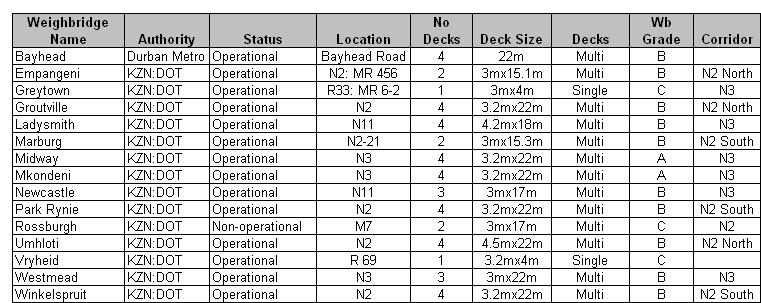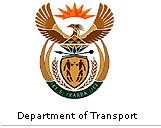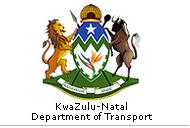Freight Traffic ManagementEnforcement of Road Traffic LegislationThe KwaZulu-Natal Department of Transport is tasked with
the responsibility for the enforcement of all road traffic
and road freight transport legislation in the areas within
the jurisdiction of the provincial Road Traffic
inspectorate (RTI).
The introduction of the Land Transport Transition Act has
placed further responsibility on the Freight Directorate
of KZN:DOT to implement the national policies in respect
of freight transport in all modes within the province.
The National Road Traffic Act is the basis for the
regulation of road traffic and, with the introduction of
the Administrative Adjudication Act and the formation of
the Road Traffic Management Corporation, the enforcement
of
road traffic legislation enters a new era.
The activities of the Department and the RTI in relation
to Freight Traffic as well
as the results of the overloading enforcement activities
in 2006, are described in this section . Overloading ControlResearch has shown that overloaded heavy vehicles are
responsible for approximately 60 percent of the damage to
the road network, and in South Africa this represents at
least R750 million per annum. During 1998, a strategy for
vehicle overloading control was formulated by the KwaZulu-
Natal Department of Transport. Overloading on South
African roads is estimated at 25%. However, in KZN
overloading is recorded at only 12% of all heavy
vehicles.
There are 14 provincial weighbridges in KwaZulu-Natal
located at:

|
Click here for a map of KZN Weighbridges
In 1998 the total number of vehicles weighed on the 14
provincial weighbridges was 33,312. In l999 the number
weighed had increased substantially to 72,640, which is an
increase of 118%. In 2000 there was a further 90%
increase from the previous year.
During 2006, a total of 185,798 vehicles were weighed at
the 13 operational provincial weighbridges, of which
146,342 were weighed on the N3 corridor. There has been a
continued significant decrease in the extent of
overloading on the N3 corridor from approximately 16% to
approximately 11%. When compared with 25% estimated for
the rest of the country it is an excellent achievement.
The overloading control statistics are very positive and
are the fruits of concerted overloading control using the
technical expertise of the Freight Directorate and
sustained law enforcement by the Road Traffic
Inspectorate.

|
As shown in the above table, the numbers of vehicles
weighed were very similar for 2005 and 2006 but the
percentage of overloaded vehicles was reduced by 17.7%.
It is still apparent, however, that many carriers are not
making serious attempts to control the loading of their
vehicles as is shown in the following table.
Vehicles Weighed and Overloaded by Commodity - 2006Maintaining the Standard of WeighbridgesThe Freight Directorate within the KZN Department of
Transport has the responsibility for ensuring that all
weighbridges in the province are fully functional and
accurate at all times. All weighbridges
are tested and calibrated
bi-annually and maintained quarterly. When necessary,
equipment is upgraded to ensure that standards are
maintained. Construction and UpgradingConstruction of the Gingindlovu Traffic Control Centre
(TCC) was commissioned after many years of delay due to
budget constraints. This weighbridge will help protect the
provincial road network as it is located at an
intersection of two main roads that carry a very
high volume of trucks, a high percentage of which are
overloaded. The first phase (which includes
offices, weighbridge, brake-tester and inspection pit)
was completed at the end of June 2007. In phase two, two
houses to accommodate staff will be constructed which will
also help in securing the property.
A large roof covering the whole platform was built at
Mkondeni to help the traffic officers to carry on with
weighing activities even during inclement weather. This
will improve efficiency at the weighbridge.
Ladysmith weighbridge was upgraded to a 22m full 4 deck
standard. This will help to improve the
efficiency of the weighing activities as the upgrade
facility will be able to weigh all configurations of
vehicles without having to move them during weighing.
At Midway weighbridge the decks have been cleaned and
repainted. The asphalt roadway from the entrance to the
Traffic Control Centre [TCC] and the road to the
weighbridge have been re-surfaced. Weigh-In-Motions (WIM)Five new WIMS were constructed in liaison with Regional
Directors. These will enable the Department to gather
accurate information on traffic volumes and
overloading control from which the maintenance plans can
be accurately calculated and law enforcement activities co-
ordinated. An additional 9 WIMS have been authorised, and
will be installed in the next financial year. Vehicle Load Monitors (VLM)Mobile weighing mats that are installed at strategic
locations are
used to monitor overloading control on provincial
roads. Weighing was done at Pieters Station and Noodsberg
to monitor trucks using these
routes. These sites will continue to be monitored, and
any
overloaded vehicles will be sent to the nearest
weighbridge where they will be fined. Other
sites have been identified for further VLM surveys. Road Transport Management System (RTMS)The Road Transport Management System (RTMS), previously
known as the Load Accreditation Programme (LAP), is an
initiative to introduce self-regulation in the heavy-
vehicle industry. The RTMS will encourage consignees,
consignors and hauliers to implement a vehicle management
system that preserves the road infrastructure, improves
road safety and increases productivity. Four KZN timber
transporters have been accredited, and several more would
like to participate. Performance-Based Standards (PBS) is
a new
approach to vehicle design that has been pioneered in
Australia, Canada and New Zealand, and has significant
potential for
improving safety and vehicle efficiency without
compromising the road infrastructure.
Two pilot projects were identified in KZN to
demonstrate and evaluate PBS with Mondi and Sappi. Abnormal LoadsTo protect the roads as well as for reasons
of road safety and traffic management, the permissible
dimensions and masses of vehicles operating on public
roads are limited by the Road Traffic Act and Regulations.
In all industrialised countries it is necessary to have a
traffic management system that can accommodate vehicle
dimensions or weight that cannot practically
comply with the provisions of the Road Traffic Act and
Regulations.
In such cases the Act empowers road authorities to issue
exemption permits for the movement of abnormal loads under
strictly controlled conditions in terms of guidelines set
out in the TRH 11 document. The only major grounds for
granting exemption permits are:
• Technical necessity – e.g., mobile cranes,
indivisible fabrications.
• National emergencies – e.g.,
transformers.
• Public interest – e.g., Comrades
Marathon.
The Freight Directorate has ensured control of the abnormal
loads by insisting that any load of 125 tons or more is
professionally weighed and route clearances are carried
out.
No other provinces apply this type of control. More than 10,000 permits for abnormal load movements were
issued by the Department's Permit Office in 2006. The
revenue generated from these permits was approximately
R5.0 million. Road Traffic InspectorateThe Road Traffic Inspectorate of the KwaZulu-Natal
Department
of Transport is responsible for the enforcement of
legislation controlling all aspects of the road freight
industry throughout the province.
The RTI has its headquarters in Pietermaritzburg. In
addition there are four regional offices i.e.
Pietermaritzburg, Empangeni, Ladysmith and Durban. Other Freight Transport ActivitiesSpeed ControlThe monitoring of the speed of heavy goods vehicles (HGV)
speed is an ongoing activity that is performed randomly
in all areas of the province. In South Africa the maximum permissible speed of HGVs
(over
3,500 kgs gross vehicle mass) is 80 km per hour, however,
the specifications of most goods vehicles permit them to
be driven at speeds of up to 120 km per hour, and thus
there is a constant temptation for drivers to use the
power potential of the vehicles to exceed the speed limit.
The monitoring of speed limits of HGVs is of critical
importance due to the fact that the stopping distance for
a vehicle, or combination of vehicles, increases
exponentially with increasing weight and speed, and the
ability to control large vehicles at speed is severely
impaired.
The fact that the large vehicle combinations use the same
road space as light vehicles poses very significant
threats to life and safety. Road PatrolsThe Officers of the RTI perform routine patrols
of roads within their areas to maximise their visibility
and impact on the behaviour of drivers of all categories
of vehicles. This activity is coupled to routine stopping
and checking of vehicle registrations, operators' cards,
drivers' licenses, wearing of seatbelts and vehicle
condition. Vehicle InspectionsThe routine inspection of vehicles (especially heavy goods
vehicles) is an important function of the RTI. Roadside
inspections are the only deterrent to vehicle
unroadworthiness.
Inspectors look for defective equipment in the primary
safety systems of vehicles, including brakes, tyres,
lights, steering and other defects. Checking Vehicle DimensionsOfficers perform routine roadside checks on the legality
of vehicle dimensions to the number of illegal
vehicles on the road network.
|



